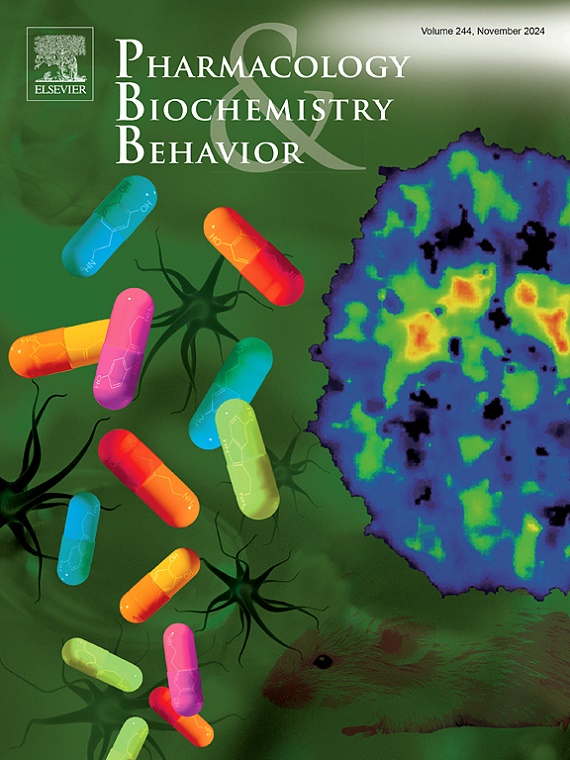From colours to cravings: Exploring conditioned colour preference to ethanol in zebrafish
IF 3.3
3区 心理学
Q1 BEHAVIORAL SCIENCES
引用次数: 0
Abstract
Conditioned preference paradigms like conditioned colour preference tests (CCP) can be used to investigate addictive drug seeking in zebrafish (Danio rerio), but many aspects of this procedure require further study. Conditioned preference can be tested with either biased or unbiased conditioning methods, each with their own strengths and weaknesses. The present study used unbiased stimuli to test seeking behaviour in ethanol-exposed zebrafish at different durations of drug withdrawal. Zebrafish were exposed to one of two equally preferred colours (red or yellow) while dosed with 0.8 % vol/vol ethanol or with habitat water (controls) for 1 h each day for 21 days. Next, fish experienced withdrawal for either 2-, 4-, or 8-days then were tested in a two-way red and yellow task for 10 min with their movement recorded via motion-tracking software. Fish conditioned to red showed a main effect of ethanol and a significant preference for red compared to yellow at 8-days of withdrawal but not at 2-days or 4-days of withdrawal. Fish conditioned to yellow did not show any colour preference during the 2-, 4-, or 8-days of withdrawal, but did show a main effect of withdrawal duration. This work expands our understanding of CCP paradigms in zebrafish and highlights the capacity of zebrafish to develop an association to red but not yellow under our experimental conditions.
从颜色到渴望:探索斑马鱼对乙醇的条件性颜色偏好。
条件性偏好范式(如条件性颜色偏好试验(CCP))可用于研究斑马鱼(Danio rerio)的成瘾性药物寻求,但这一过程的许多方面还需要进一步研究。条件偏好可以用有偏或无偏的条件反射方法进行测试,这两种方法各有优缺点。本研究使用无偏刺激来测试暴露于乙醇的斑马鱼在不同的戒药持续时间内的寻食行为。斑马鱼每天接触两种同样喜欢的颜色(红色或黄色)中的一种,同时摄入 0.8 % vol/vol 乙醇或生境水(对照组),持续 21 天,每天 1 小时。接下来,鱼类会经历 2 天、4 天或 8 天的戒断期,然后接受 10 分钟的红黄双向任务测试,并通过运动跟踪软件记录其运动情况。与黄色相比,对红色有条件反射的鱼在戒断 8 天后表现出乙醇的主效应和对红色的显著偏好,但在戒断 2 天或 4 天后则没有表现出这种偏好。对黄色有条件反射的鱼在戒断 2 天、4 天或 8 天内没有表现出任何颜色偏好,但表现出戒断持续时间的主效应。这项研究拓展了我们对斑马鱼CCP范式的理解,并强调了斑马鱼在我们的实验条件下对红色而非黄色产生联想的能力。
本文章由计算机程序翻译,如有差异,请以英文原文为准。
求助全文
约1分钟内获得全文
求助全文
来源期刊
CiteScore
6.40
自引率
2.80%
发文量
122
审稿时长
38 days
期刊介绍:
Pharmacology Biochemistry & Behavior publishes original reports in the areas of pharmacology and biochemistry in which the primary emphasis and theoretical context are behavioral. Contributions may involve clinical, preclinical, or basic research. Purely biochemical or toxicology studies will not be published. Papers describing the behavioral effects of novel drugs in models of psychiatric, neurological and cognitive disorders, and central pain must include a positive control unless the paper is on a disease where such a drug is not available yet. Papers focusing on physiological processes (e.g., peripheral pain mechanisms, body temperature regulation, seizure activity) are not accepted as we would like to retain the focus of Pharmacology Biochemistry & Behavior on behavior and its interaction with the biochemistry and neurochemistry of the central nervous system. Papers describing the effects of plant materials are generally not considered, unless the active ingredients are studied, the extraction method is well described, the doses tested are known, and clear and definite experimental evidence on the mechanism of action of the active ingredients is provided.

 求助内容:
求助内容: 应助结果提醒方式:
应助结果提醒方式:


